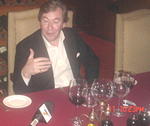|  Mark Walford is a name that carries a lot of weight in Bordeaux and Burgundy , so if he makes it a point to visit India at least once a year, it's not only because he is in love with the country he first visited in 2001. In the intervening years, with the backing of Brindco and Aman Dhall, he has introduced Domaine Chevalier, the maker of superlative white wines from Graves , into the Indian market and woke up the market to the existence of some very fine Burgundy houses. Mark Walford is a name that carries a lot of weight in Bordeaux and Burgundy , so if he makes it a point to visit India at least once a year, it's not only because he is in love with the country he first visited in 2001. In the intervening years, with the backing of Brindco and Aman Dhall, he has introduced Domaine Chevalier, the maker of superlative white wines from Graves , into the Indian market and woke up the market to the existence of some very fine Burgundy houses.
This year, too, he was in New Delhi with David Launay from Chateau Gruaud Larose, his favourite super second from Saint-Julien, Bordeaux , five of whose vintages (1989, 1996, 1999, 2000 and 2001) were served at a Delhi Wine Club dinner on December 11. What keeps bringing this jet-setting businessman, who divides his time between France , Spain , Japan and Hong Kong , back to a country where the average annual consumption works out to 500 people sharing a bottle of wine?
"In Hong Kong , you can get any wine from anywhere in the world. And in Japan , wine schools  have waiting lists, though they have many hundreds of them. There's no reason why India shouldn't be where Japan and Hong Kong are today," Walford says, justifying his faith in India . India may be 15 years behind Hong Kong (and so is China ), but trends travel much faster now than before because of the mind-boggling increase in the pace of communications. have waiting lists, though they have many hundreds of them. There's no reason why India shouldn't be where Japan and Hong Kong are today," Walford says, justifying his faith in India . India may be 15 years behind Hong Kong (and so is China ), but trends travel much faster now than before because of the mind-boggling increase in the pace of communications.
Walford was addressing the conference on 'Indian Wine Market: The Road Ahead' organised by the Indian Wine Academy at IFE-India 2005. India, Walford assures us, has come a long way since 1994, when the Taj didn't have an adequate number of corkscrews to open the bottles of wine that had been imported with Camelia Panjabi's blessings. A pointer to how the situation is changing dramatically is the permanent full house at Rasoi Vineet Bhatia, the London-based Michelin one-star chef's eponymous restaurant. "The restaurant is full of Indians. A number of them are Indians who have settled in Britain , but most of them are Indians from India ," Walford points out.
The message is unmistakable. Indians are world travellers who increasingly are going to  international fine-dining restaurants with great wines lists. The Indian palate, clearly, has evolved and it won't be very long before wine consumption goes up in certain circles in India . international fine-dining restaurants with great wines lists. The Indian palate, clearly, has evolved and it won't be very long before wine consumption goes up in certain circles in India .
Walford lists seven factors that will drive the Indian wine market forward. They are:
(1) Economic Growth: As more and more westerners arrive in India to do business, they will be entertained in a western style, which means that a bottle of wine will become an essential accompaniment to any business meal.
(2) Finesse of Indian Cuisine: Accustomed as the Indian palate is to a cuisine that combines finesse with nuance , it can easily adapt to fine wines.
(3) Brand Consciousness: A Latour or a Romanee-Conti is as recognisable a brand as a Chanel or Hermes. Asian markets are brand driven, so there's just no reason why big brands in the wine business won't do well.
(4) Health Consciousness: India , like the rest of the world, will inevitably move from 'hard' alcoholic beverages to wine mainly for health reasons.
(5) Snob Value: In English, drinking wine is a sign of savoir faire, a way to show your sophistication. This perception of wine is bound to trickle down to India .
(6) Higher Tourist Arrivals: As a greater number of upmarket tourists make India their destination, the amount of wine being consumed is bound to go up. " India has magnificent hotels and there's no reason why somebody staying at an Amar Vilas or a Raj Vilas will hesitate to order a decent bottle of wine," says Walford.
(7) The Importance of 'Face': As in other Asian cultures, the idea of 'face' is also embedded in the  Indian culture. In other Asian societies, a good wine is a staple gift for people a person considers important. There's no reason why it shouldn't replace the ubiquitous bottle of whisky in India . Indian culture. In other Asian societies, a good wine is a staple gift for people a person considers important. There's no reason why it shouldn't replace the ubiquitous bottle of whisky in India .
Signs of change are already visible. Walford cites as examples Sula's effort to market its wines, or Jet Airways serving the 1997 Cos d'Estournel in the business class of its flight to London . India may be drinking wine at the rate of just a teaspoon per head, but the 33 million Indians who form the consuming class (their number is the same as Argentina's population) continue to offer hope to a gung-ho businessman like Walford, who doesn't believe in hedging his bets on India.
Sourish Bhattacharyya
|